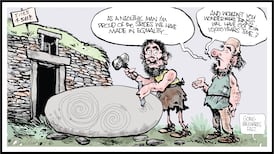The Butlers have been crossing the world to gather this week in Kilkenny for their 14th triennial rally. From 11 different countries, as far apart as Argentina and Canada, Hawaii and Denmark, they are returning to the land of their forefathers.
There will be 71 people with the name of Butler present, besides those who are related on the distaff side.
It is more than eight centuries since the Anglo-Norman Theobald Walter came to Ireland in the entourage of Prince John. He was granted lands in Wexford, Tipperary, Limerick and Kilkenny and was made chief Butler of Ireland, one of the hereditary great offices of state, which is the most ancient hereditary dignity still enjoyed by male heirs of any family in these islands, if not in Europe. The office included a prisage of wine, or the right to one tenth of the wine imported into Ireland and this privilege continued until, alas, the crown bought it back in 1810.
This great Norman family held immense power in Ireland over the next three centuries, rivalled only by the Fitzgeralds. Butlers, headquartered at Kilkenny Castle from the late 14th century, often served as governors of Ireland and were usually loyal to the King, but the 10th Earl of Ormond fought and won at Affane, the last private pitched battle in Ireland or Britain, against his cousin, the Earl of Desmond.
One of the more distinguished members of the family was James Butler, first Duke of Ormonde (the final "e" was added in the 17th century) who, as Lord Lieutenant and Chancellor of Ireland, created the Phoenix Park and founded the Royal Hospital Kilmainham, in 1684. His grandson, the second duke, switched his allegiance to the Stuart cause and was exiled to France; but as he had no heirs, the titles and estates reverted, ironically, to the Catholic branch of the family - though by the turn of the 18th century the family had conformed.
In the middle of the next century, the main block of Kilkenny Castle was rebuilt in its present castellated style and the wing containing the Long Gallery was added.
During the Civil War in 1922, Republicans were besieged in the castle by the government forces. The Ormondes, together with their pet Pekinese, chose to remain in situ in their bedroom over the great gate, which was the main focus of attack. Outside their door was a machine-gun manned by the defenders and if Ormondes wanted anything to eat, they had to crawl along the passages hoping to avoid the bullets.
Though only one man was wounded, much damage was done to the castle, the windows smashed and some of the pictures and furniture destroyed. Ten years later the family were still doing repairs and they decided to abandon the castle. In 1935, the contents were put up for auction.
With the death of Charles Ormonde in 1997, the marquessate became extinct, but the earldom and title Chief Butler is still extant and, in the absence of anyone coming forward with a better claim, the present 32nd Chief Butler is Piers Butler, Viscount Mountgarret, a direct descendant of the Eighth Earl of Ormond. He is at present living in America.
In 1967, Hubert Butler the essayist, his kinsman Paddy Butler, 28th Baron Dunboyne, and George Butler, a retired chief superintendent of the Garda in Waterford, formed the Butler Society. At the first rally, over 400 Butlers sat down to dine in the semi-derelict castle. By flickering candlelight, they ate a banquet that had been brought by fast car from a hotel, carried up a ladder and through a window into the picture gallery.
It was at this rally that the sixth marquess gave the castle to the people of Kilkenny. Later he bought the land in front of the castle from the trustees in order that "it should never be built on and the castle would be seen in all its dignity and splendour" and at the second Butler rally he presented it to Kilkenny. Astonishingly,
there is no plaque in the castle or in the grounds to record these generous gifts to the people of Ireland.
Since the first rally, the Butlers have dined in more comfort as the OPW has restored the castle and they now feast in the refurbished Parade Tower, with its nine-foot walls and deep embrasures.
For six days from tomorrow, the Butlers will meet with their kinsmen and visit houses and castles connected to the family, such as Mount Juliet, which was built by the Carrick Butlers, Shankill Castle, which belonged to the same branch of the family as the Butler who murdered Wallenstein in the Thirty Years War, and a Butler tower house in Wexford. In New Ross, they will see the tapestry depicting the Normans landing in Ireland and they will go aboard the Dunbrody, the replica emigrant ship that took so many of their forebears to the New World. Back in Kilkenny, a lecture on DNA will give genealogists another path back through the history of the family.
One of the objects of the society was to bring together the scattered branches of the Butlers and their kindred and to renew old links that were in danger of breaking. It is an achievement of the society that so many of the members who come back from far across the seas have been to previous rallies and are now old friends. The society can boast of having been the instigator of even closer ties in that one German Butler married a French Butler and another German Butler married an Irish member - all as a result of Butler rallies.
Melosina Lenox-Conyngham, a niece of Hubert Butler, is secretary of the Butler Society.









